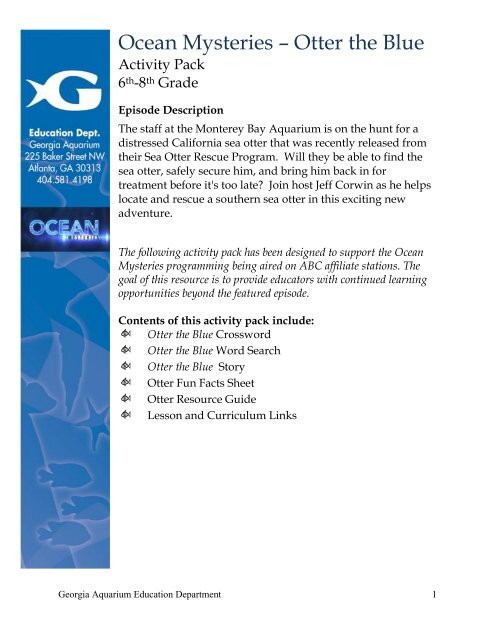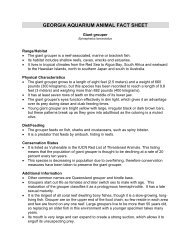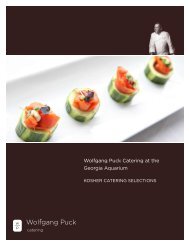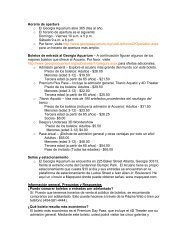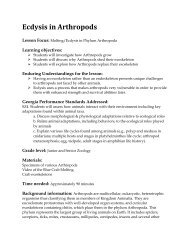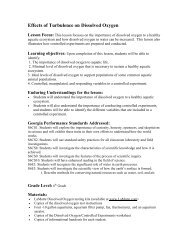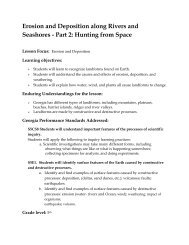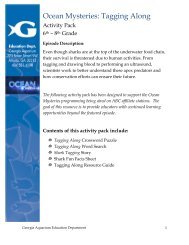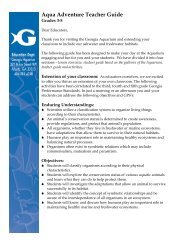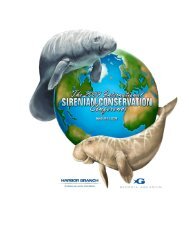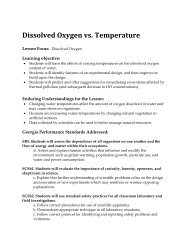Ocean Mysteries – Otter the Blue - Georgia Aquarium
Ocean Mysteries – Otter the Blue - Georgia Aquarium
Ocean Mysteries – Otter the Blue - Georgia Aquarium
You also want an ePaper? Increase the reach of your titles
YUMPU automatically turns print PDFs into web optimized ePapers that Google loves.
<strong>Ocean</strong> <strong>Mysteries</strong> <strong>–</strong> <strong>Otter</strong> <strong>the</strong> <strong>Blue</strong><br />
Activity Pack<br />
6 th -8 th Grade<br />
Episode Description<br />
The staff at <strong>the</strong> Monterey Bay <strong>Aquarium</strong> is on <strong>the</strong> hunt for a<br />
distressed California sea otter that was recently released from<br />
<strong>the</strong>ir Sea <strong>Otter</strong> Rescue Program. Will <strong>the</strong>y be able to find <strong>the</strong><br />
sea otter, safely secure him, and bring him back in for<br />
treatment before it's too late Join host Jeff Corwin as he helps<br />
locate and rescue a sou<strong>the</strong>rn sea otter in this exciting new<br />
adventure.<br />
The following activity pack has been designed to support <strong>the</strong> <strong>Ocean</strong><br />
<strong>Mysteries</strong> programming being aired on ABC affiliate stations. The<br />
goal of this resource is to provide educators with continued learning<br />
opportunities beyond <strong>the</strong> featured episode.<br />
Contents of this activity pack include:<br />
<strong>Otter</strong> <strong>the</strong> <strong>Blue</strong> Crossword<br />
<strong>Otter</strong> <strong>the</strong> <strong>Blue</strong> Word Search<br />
<strong>Otter</strong> <strong>the</strong> <strong>Blue</strong> Story<br />
<strong>Otter</strong> Fun Facts Sheet<br />
<strong>Otter</strong> Resource Guide<br />
Lesson and Curriculum Links<br />
<strong>Georgia</strong> <strong>Aquarium</strong> Education Department 1
<strong>Otter</strong> <strong>the</strong> <strong>Blue</strong> Crossword<br />
Student Sheet<br />
1<br />
Across<br />
2. SORAC matches stranded pups with a surrogate ______ to learn necessary survival<br />
skills.<br />
5. When <strong>the</strong> pup is ready, <strong>the</strong> staff will _____ it back in to <strong>the</strong> wild.<br />
6. The methods developed by SORAC have greatly increased _____ rates for stranded<br />
otter pups.<br />
Down<br />
1. Without food sea otters can become _____, lacking fluids in <strong>the</strong>ir bodies.<br />
3. Before being released, sea otters have a _____ surgically implanted.<br />
4. Researchers can track released sea otters through _____ telemetry to monitor <strong>the</strong>ir<br />
success.<br />
7. If a sea otter is not foraging well, SORAC staff may ______ it and bring it back to <strong>the</strong><br />
<strong>Aquarium</strong>.<br />
<strong>Georgia</strong> <strong>Aquarium</strong> Education Department 2
<strong>Otter</strong> <strong>the</strong> <strong>Blue</strong> Crossword<br />
Answer Sheet<br />
Across<br />
2. MOTHER<br />
5. RELEASE<br />
6. SURVIVAL<br />
Down<br />
1. DEHYDRATED<br />
3. TRANSMITTER<br />
4. RADIO<br />
7. RECAPTURE<br />
<strong>Georgia</strong> <strong>Aquarium</strong> Education Department 3
<strong>Otter</strong> <strong>the</strong> <strong>Blue</strong> Word Search<br />
Student Sheet<br />
C A F I Q P G D R K J M H S I Y C V<br />
E F K K I V Q Q Z X M G C X P P Q E<br />
B B N J P J A V O R U R D L E R R T<br />
N G B X C B M H W O A W K A A E O E<br />
F M L A E O K W L S B G W V L X K R<br />
R O O R C O N S E R V A T I O N Z I<br />
R E S C U E N H T E H U I V R B H N<br />
G J H Y J R M E S C J Z E R F K L A<br />
L N Y A O Y L T R P G Z Y U J G J R<br />
G K I H B E H A V E Y C M S H S S I<br />
F Q K G M I E F X R D D Z H M C J A<br />
L L B E A S L N C J D Y Z R Q J H N<br />
E P T R E R Y I P I P E D L K T X W<br />
A R G R N Z O H T E T A G O R R U S<br />
Y V X V X Z S F S A P B L D T J F V<br />
E F Q X A P Z S E N T N O P L D S J<br />
Z J T J V I G U B J M E P K J P F D<br />
Y V O W M G L X L L Z O D O F Z M W<br />
TELEMETRY<br />
CONSERVATION<br />
ELKHORN SLOUGH<br />
FORAGING<br />
SURVIVAL<br />
REHABILITATE<br />
RESCUE<br />
RESEARCH<br />
SURROGATE<br />
VETERINARIAN<br />
<strong>Georgia</strong> <strong>Aquarium</strong> Education Department 4
<strong>Otter</strong> <strong>the</strong> <strong>Blue</strong> Word Search<br />
Answer Sheet<br />
C A F I Q P G D R K J M H S I Y C V<br />
E F K K I V Q Q Z X M G C X P P Q E<br />
B B N J P J A V O R U R D L E R R T<br />
N G B X C B M H W O A W K A A E O E<br />
F M L A E O K W L S B G W V L X K R<br />
R O O R C O N S E R V A T I O N Z I<br />
R E S C U E N H T E H U I V R B H N<br />
G J H Y J R M E S C J Z E R F K L A<br />
L N Y A O Y L T R P G Z Y U J G J R<br />
G K I H B E H A V E Y C M S H S S I<br />
F Q K G M I E F X R D D Z H M C J A<br />
L L B E A S L N C J D Y Z R Q J H N<br />
E P T R E R Y I P I P E D L K T X W<br />
A R G R N Z O H T E T A G O R R U S<br />
Y V X V X Z S F S A P B L D T J F V<br />
E F Q X A P Z S E N T N O P L D S J<br />
Z J T J V I G U B J M E P K J P F D<br />
Y V O W M G L X L L Z O D O F Z M W<br />
<strong>Georgia</strong> <strong>Aquarium</strong> Education Department 5
<strong>Otter</strong> <strong>the</strong> <strong>Blue</strong> Story Student Sheet 1<br />
Have students as a group or individually come up with <strong>the</strong> following<br />
words. Then, insert <strong>the</strong> words into <strong>the</strong> attached story and read aloud.<br />
1. Year _______________________________<br />
2. Number _______________________________<br />
3. Adjective _______________________________<br />
4. Adjective (starting with “s”) _______________________________<br />
5. Verb (starting with “r”) _______________________________<br />
6. Verb (starting with “c”) _______________________________<br />
7. Verb (past tense) _______________________________<br />
8. Adjective _______________________________<br />
9. Adjective _______________________________<br />
10. Adjective _______________________________<br />
11. Verb _______________________________<br />
12. Noun (type of costume) _______________________________<br />
13. Noun (something to hide behind) ____________________________<br />
14. Noun _______________________________<br />
15. Adverb _______________________________<br />
<strong>Georgia</strong> <strong>Aquarium</strong> Education Department 6
<strong>Otter</strong> <strong>the</strong> <strong>Blue</strong> Story Student Sheet 2<br />
In ____________, <strong>the</strong> <strong>Georgia</strong> <strong>Aquarium</strong> welcomed ____________ rescued sea otters into its<br />
1. Year 2. Number<br />
collection. These orphaned sea otter pups had been deemed un-releasable by <strong>the</strong>ir<br />
____________caretakers in California. The SORAC program, which stands for <strong>the</strong> ____________<br />
3. Adjective<br />
4. Adjective (starting with “s”)<br />
<strong>Otter</strong> ____________and ____________, is continuously rescuing and rehabilitating sea otters<br />
5. Verb (starting with “r”) 6. Verb (starting with “c”)<br />
____________along <strong>the</strong> shores of California, <strong>the</strong> ____________ habitat for sou<strong>the</strong>rn sea otters.<br />
7. Verb (past tense)<br />
8. Adjective<br />
Once <strong>the</strong>se sea otters are rehabilitated, it is <strong>the</strong> ____________ goal to release <strong>the</strong> pups into <strong>the</strong><br />
9. Adjective<br />
wild as ____________ individuals. To do this, care is taken so that <strong>the</strong> otters do not imprint on<br />
10. Adjective<br />
humans. This way, when <strong>the</strong> otter is back in <strong>the</strong> wild, <strong>the</strong>y will not recognize humans as <strong>the</strong>ir<br />
caretakers and will not be tempted to ____________ <strong>the</strong>m. To do this, caretakers must dress<br />
11. Verb<br />
<strong>the</strong>mselves to hide <strong>the</strong>ir faces; this is usually done by wearing a ____________ mask or a<br />
12. Noun (type of costume)<br />
____________ while interacting with <strong>the</strong> otter pups.<br />
13. Noun (something to hide behind)<br />
When released, otter pups are outfitted with a tracking ____________ which allows researchers<br />
14. Noun<br />
to locate <strong>the</strong>m in <strong>the</strong> wild. Thanks to <strong>the</strong> efforts underway at <strong>the</strong> SORAC program, <strong>the</strong><br />
rehabilitated otters will ____________ live <strong>the</strong> rest of <strong>the</strong>ir lives fully in <strong>the</strong> wild.<br />
15. Adverb<br />
<strong>Georgia</strong> <strong>Aquarium</strong> Education Department 7
<strong>Otter</strong> Fun Facts Sheet<br />
Before <strong>the</strong> Monterey Bay <strong>Aquarium</strong> began rescuing sea otter pups in 1984, no one<br />
knew how to keep pups alive once separated from <strong>the</strong>ir mo<strong>the</strong>rs.<br />
More than 500 sea otters have come through SORAC program.<br />
Many of <strong>the</strong> sea otters raised by Monterey Bay’s surrogate mo<strong>the</strong>rs have been<br />
successfully released and have gone on to breed and raise <strong>the</strong>ir own pups in <strong>the</strong><br />
wild.<br />
SORAC stands for Sea <strong>Otter</strong> Research and Conservation and is dedicated to <strong>the</strong><br />
protection of sea otters in Monterey Bay and surrounding areas.<br />
SORAC rescues stranded pups, stabilizes <strong>the</strong>ir health, cares for <strong>the</strong>m, establishes a<br />
surrogate mo<strong>the</strong>r, and releases <strong>the</strong>m back into <strong>the</strong> wild if <strong>the</strong>y are good candidate.<br />
<strong>Otter</strong>s that do not forage or navigate well after release may be recaptured and<br />
returned to <strong>the</strong> <strong>Aquarium</strong> to rest and gain weight.<br />
It sometimes takes 3 or 4 releases for a sea otter to adapt to life in <strong>the</strong> wild.<br />
Sea otters are a keystone species: a predator that helps keep marine ecosystems in<br />
balance.<br />
Tidal creeks form winding networks of water through <strong>the</strong> salt marshes and mud<br />
flats, creating important foraging areas for sea otters.<br />
Aside from San Francisco Bay, <strong>the</strong> largest area of tidal marsh in California is found<br />
in Elkhorn Slough.<br />
When not eating or grooming, otters relax on <strong>the</strong>ir back and float with <strong>the</strong> tides.<br />
Parasites and infectious diseases cause more than 40 percent of sea otter deaths.<br />
Sea otters can eat up to 25% of <strong>the</strong>ir body weight each day. Much of <strong>the</strong>ir diet<br />
consists of sea urchins and o<strong>the</strong>r marine invertebrates.<br />
The sea otter is <strong>the</strong> only carnivore to have four incisor teeth in its lower jaw and one<br />
of <strong>the</strong> only one that uses tools. These tools such as rocks, along with <strong>the</strong>ir teeth, are<br />
used to break open <strong>the</strong> shells of crabs, sea urchins, and o<strong>the</strong>r shellfish.<br />
Telemetry is <strong>the</strong> technique used by researchers to study animals and <strong>the</strong>ir<br />
movements from afar by attaching radio transmitters.<br />
Sea otters can often be seen grooming <strong>the</strong>mselves and o<strong>the</strong>r otters. This increases<br />
blood flow, cleans <strong>the</strong>ir fur, and traps air pockets beneath <strong>the</strong> fur. This trapped air is<br />
warmed by <strong>the</strong> otter’s body and creates ano<strong>the</strong>r barrier to fight <strong>the</strong> cold water.<br />
A group of sea otters is called a raft.<br />
<strong>Georgia</strong> <strong>Aquarium</strong> Education Department 8
<strong>Otter</strong> Resource Guide<br />
Internet Resources:<br />
Alaska Sea Life Center<br />
http://www.alaskasealife.org/New/about-ASLC/index.phppage=firstpage.php<br />
Information about <strong>the</strong> Alaska Sea Life Center’s research and rehabilitation efforts with<br />
sea otters and o<strong>the</strong>r sea animals.<br />
Friends of <strong>the</strong> Sea <strong>Otter</strong><br />
http://www.seaotters.org/index.html<br />
This organization’s purpose is to protect sea otters and inform <strong>the</strong> public about <strong>the</strong>ir<br />
unique behaviors and habitat.<br />
<strong>Georgia</strong> <strong>Aquarium</strong> <strong>–</strong> 4R Program<br />
http://www.georgiaaquarium.org/support-us/4R/<br />
Information about <strong>Georgia</strong> <strong>Aquarium</strong>’s sea otter rescue partnerships and o<strong>the</strong>r key<br />
conservation projects at <strong>the</strong> <strong>Georgia</strong> <strong>Aquarium</strong>.<br />
The Marine Mammal Center<br />
http://www.marinemammalcenter.org<br />
This center rescues ill, injured, or orphaned marine mammals and provides education<br />
about marine mammals and <strong>the</strong>ir habitats.<br />
Monterey Bay <strong>Aquarium</strong> <strong>–</strong> Sea <strong>Otter</strong> Research and Conservation<br />
http://ww.montereybayaquarium.org/cr/cr_sorac/sorac_rescue.aspx<br />
Description of <strong>the</strong> Monterey Bay <strong>Aquarium</strong>’s Sea <strong>Otter</strong> Research and Conservation<br />
Program.<br />
The <strong>Otter</strong> Project<br />
http://www.otterproject.org/site/pp.aspc=8pIKIYMIG&b=1323147<br />
General information about sea otters, careers involving <strong>the</strong>m, photographs, and what<br />
you can do to help sea otters are included on this website.<br />
Book Resources:<br />
Brust, B. W. (1991). Sea otters. Mankato, MN: Creative Education<br />
Kelsey, E., & White, D. (1999). Saving sea otters: stories of survival. Monterey, CA:<br />
Monterey Bay <strong>Aquarium</strong> Press.<br />
Murray, P. (1996). Sea otters. Columbus, OH: Newfield Publications.<br />
Smith, R. (1990). Sea otter rescue: <strong>the</strong> aftermath of an oil spill. New York, NY: Cobblehill<br />
Books.<br />
<strong>Georgia</strong> <strong>Aquarium</strong> Education Department 9
Lesson and Curriculum Links<br />
Below is a list of resource materials which contain age appropriate lesson<br />
plans and o<strong>the</strong>r related classroom curriculum.<br />
Defenders of Wildlife Sea <strong>Otter</strong> Unit Teacher Manual<br />
http://www.kidsplanet.org/tt/seaotter/pdf/teachers.pdf<br />
Background information of sea otter biology and behavior with a focus on <strong>the</strong> social<br />
implications and conflicts surrounding sea otters. These lessons are designed to<br />
integrate reading, writing, social studies, and technology into <strong>the</strong> science curriculum.<br />
Glacier Bay National Park <strong>–</strong> Sea <strong>Otter</strong> Lesson Plans<br />
http://www.nps.gov/glba/forteachers/sea-otters-lesson-plans.htm<br />
Lesson plans covering sea otter behavior, diet, and population history.<br />
Lesson Planet-Discover <strong>the</strong> Similarities: Marine Mammal Rescue<br />
http://www.lessonplanet.com/lesson-plans/marine-mammal<br />
In this lesson, students will research <strong>the</strong> career of marine mammal rescuers and<br />
compare it to <strong>the</strong>ir own lives.<br />
Sea World and National Geographic <strong>–</strong> Conservation Around <strong>the</strong> World<br />
http://www.seaworld.org/just-for-teachers/guides/pdf/saving-<strong>the</strong>-wild-6-8.pdf<br />
This website contains information about animal conservation and geography with<br />
hands-on activities. It helps students understand <strong>the</strong>ir place in <strong>the</strong> world and <strong>the</strong><br />
importance of being stewards of <strong>the</strong>ir environment and its animal inhabitants.<br />
<strong>Georgia</strong> <strong>Aquarium</strong> Education Department 10


